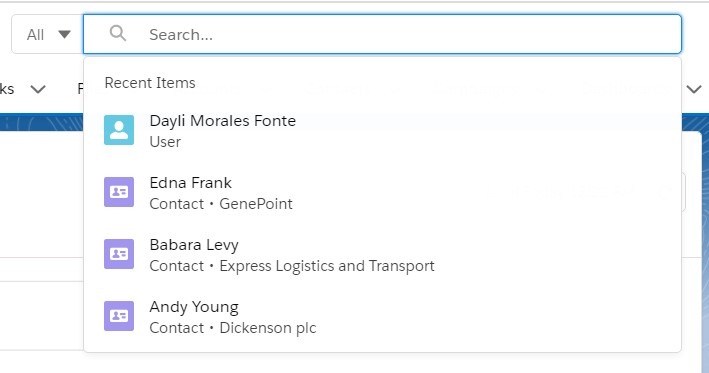When you’re new to Salesforce, it’s easy to get lost in the lingo. There’s just so much information to digest that it can be overwhelming and frankly, exhausting. That’s why we created this handy glossary guide, to help you understand the terminology as you embark on your Salesforce journey.
In this list, we’ve included the most common key terms that you’ll encounter at the very beginning of your Salesforce experience. As you get further down your learning path, we’ll provide you with more advanced terms (lists coming soon), so that you can learn as you go.
A
Account
An account is an organization, company, or consumer that you want to track—for example, a customer, partner, or competitor.
Activity
Event, task, registered call, or an email you have sent to a customer. You can relate an activity to other records (account, lead, opportunity, or a case).
Administrator (System Administrator)
One or more individuals in your organization who can configure and customize the application. Users assigned to the System Administrator profile have administrator privileges.
Apex
Object-oriented programming language used by developers to create applications that interact with Salesforce through APIs.
API (Application Programming Interface)
Interface that allows several software elements to connect with each other and exchange information.
AppExchange
Salesforce online marketplace from where you can download and install more than 4,000 solutions for your organization. Allows you to explore and share applications and services for the Lightning platform. You can download and install third-party integrations into your organization.


An AppExchange’s Quick Guide
Check out our guide to quickly discover what you can find there, how it works and what are its main advantages.
Article
Articles capture information about your company’s products and services that you want to make available in your knowledge base.
C
Campaign
A marketing initiative, such as an advertisement, direct mail, or conference, that you conduct in order to generate prospects and build brand awareness. The relationship between campaigns and opportunities allows ROI to be measured and monitored.
Case
Detailed description of a customer’s feedback, problem, or question. Used to track and solve your customers’ issues.
Classic platform
Salesforce development platform that presents the initial web user interface with the functionalities that characterize it.
Community
Communities are customizable public or private spaces for employees, end-customers, and partners to collaborate on best practices and business processes.
Contact
Individuals associated with your accounts.
Contact record
Contains details such as name, address, email, and phone number.
Customer Relationship Management (CRM)
A technology for managing all your company’s relationships and interactions with customers and potential customers. A CRM system gives everyone — from sales, customer service, business development, recruiting, marketing, or any other line of business — a better way to store, access, and manage all customer data.

What is a CRM? 12 functionalities necessary for your business
CRM platforms are on the list of the best technological tools to improve relationships with your customers, but do you know what they consist of and what features you need?
Custom field
Information that you can add in a Salesforce standard or custom object to capture data you need from your organization.
Custom object
Allows you to store information unique to your organization.
Custom report
Reports that have been customized by the user to include exactly the information they want to see.
Customer 360
CRM integrated platform that can be used by all your teams to manage and grow customer relationships, linking marketing, sales, trade, services and information technology departments.
D
Dashboard
Shows the results of the reports through an integrated view through visual components such as graphs, indicators, tables, metrics, etc

E
Ecosystem
Consists of companies, consultants and independent developers who create applications on the Salesforce platform. They are supported by the Salesforce team, which regularly develops new tools to improve the developer experience.
Einstein Analytics
Advanced analytics powered by artificial intelligence that automatically analyzes billions of data combinations to surface predictive insights and prescriptive recommendations.

External User
External users are users with Community, Customer Portal, or partner portal licenses.
F
Field
Categories to organize data objects on Salesforce similar to the columns in a spreadsheet. Every standard and custom object has fields attached to it. Example of standard fields include identity, system, name and address.
Flow Builder
Interface used to build individual flows. It allows you to create code-like logic without the requirement of knowing a programming language.
Forecasts
Projections of sales based on the organization’s fiscal year.
G
Group
A group is a set of users. Groups can contain individual users, other groups, or the users in a role. Groups can be used to help define sharing access to data or to specify which data to synchronize in Salesforce for Outlook configurations or Lightning Sync configurations. Users can define their own personal groups. Administrators can create public groups for use by everyone in the organization.
Group Edition
A product designed for small businesses and workgroups with a limited number of users.
Global Search
Search for more records and fields in Salesforce from the header search box. Global search keeps track of which objects you use and how often you use them, and arranges the search results accordingly. Search results for the objects you use most frequently appear at the top of the list.

H
Heroku
A cloud platform that allows companies to build, deliver, monitor and scale apps.

Highlights Panel
A customizable table of up to four columns and two rows that appears at the top of every primary tab in a Salesforce console. It lets you view key information about records at a glance.
Home Tab
Starting page from which users can choose sidebar shortcuts and options, view current tasks and activities, or select another tab.

I
Instance
The server that your organization lives on.
Interaction Log
An area in a Salesforce console where you can jot notes about the main record you’re working on without clicking a button, viewing a new tab, or scrolling to the Notes & Attachments related list. Interaction logs are archived on the Activity History related list for easy review and retrieval. Administrators can customize interaction logs to include task fields.
K
Knowledge Agent
Salesforce uses this term to represent a specific type of user. Knowledge agents are article consumers in the internal Salesforce Knowledge app. These users can access the Articles tab to search for and view articles, but they cannot create, edit, or manage articles.
L
Lead
A lead is a prospect who has expressed interest in your product or service.
Lead nurturing
Process of preparing and accompanying leads throughout the purchase cycle, from the first contact with your brand until they become loyal customers.

Lead scoring
Process in which a potential customer is assigned a numerical value to quantify their interest in your business.

Library
A file repository in Salesforce CRM Content.
Lightning Platform
Application development platform that is designed to simplify processes for business users by accelerating application development and performance, providing a more engaging experience.
Salesforce Lightning offers a new and improved interface with additional features that make it easier and more attractive to users, while Salesforce Classic offers the updated initial interface.
List View
A list display of items (for example, accounts or contacts) based on specific criteria. Salesforce provides some predefined views. In the Agent console, the list view is the top frame that displays a list view of records based on specific criteria. The list views you can select to display in the console are the same list views defined on the tabs of other objects. You cannot create a list view within the console.
M
Marketing Cloud
Digital marketing software that allows you to target your clients using personalized content with little or no human intervention, as well as connect data across multiple sources and devices to obtain a unified view of each one of them.

Your Complete Guide to Marketing Cloud
Say hello to Marketing Cloud, the world’s #1 marketing platform. In this post, we’re going to go through the ins and outs of Salesforce’s Marketing Cloud and explain why it’s the best choice for your marketing needs.
Marketing User
One or more individuals in your organization who can manage campaigns. Administrators can designate someone as a Marketing User by selecting the Marketing User checkbox in the user’s personal information. Only marketing users can create, edit, and delete campaigns or configure advanced campaign setup. With additional user permissions, marketing users can use the Data Import Wizard to add campaign members and update their status.
Milestones
Mandatory stages in your support process. They are metrics that represent the service levels to provide to each of your clients. Examples: first response times and case resolution.
N
Navigation Tab
A tab with a drop-down button in a Salesforce console that lets you select and view object home pages.
O
Object
An object allows you to store information in your Salesforce organization similar to a tab on a spreadsheet.
Opportunities
Allows you to manage and track your potential sales. Opportunities are sales in process.
Organization (Org)
Virtual space provided by Salesforce to a customer with a defined set of licensed users. It includes all your data and applications, and they are independent from the rest of the organizations. It offers strict security and protection of information.
Owner
Individual user to which a record (for example, a contact or case) is assigned.
P
Package
Group of components and applications available to other organizations through the AppExchange. You use packages to bundle an app along with any related components so that you can upload them to AppExchange together.

Pardot
A powerful B2B marketing automation tool to help marketing and sales and marketing teams find and nurture the best leads, close more deals, and maximize ROI.
Partner
Partners are the companies with which you collaborate to close your sales deals. For each opportunity or account you create, the Partners related list allows you to store information about your partners and the roles they play in the opportunity or account. A partner must be an existing account within Salesforce. Selecting a partner role automatically creates a reverse partner relationship with the associated account so that both accounts list the other account as a partner.
Permission
A permission is a setting that allows a user to perform certain functions in Salesforce. Permissions can be enabled in permission sets and profiles. Examples of permissions include the “Edit” permission on a custom object and the “Modify All Data” permission.
Personal Edition
A Salesforce edition designed for individual sales representatives and single users.
Pipeline
Calculated amount of open opportunities that have a close date within the quarter. Displays on forecast detail and edit pages. For managers, this amount includes open opportunities for them and their entire team.
Process builder
Helps automate your business processes and provides you with a graphical representation when you create them.
Profile
Controls what a user can do in Salesforce. Each profile can be assigned to one or more users at a time.
Professional Edition
A Salesforce edition designed for businesses who need full-featured CRM functionality.
Profile
A profile controls what a user can do in Salesforce. Each user is assigned a profile.
Q
Queue
Holding area for items (leads, cases, users, custom objects, etc.) before they are processed. Salesforce uses queues in a number of different features and technologies.
QuickStart Package
A Salesforce implementation package that consists of a fast track deployment, basic system configuration and set up, data migration, and essential training. It’s best for small businesses looking to get started with Salesforce quickly and efficiently for a single group of users. QuickStart Packages are available for Sales Cloud, Service Cloud, Customer Communities, and Marketing Cloud.

What is a Quickstart Package?
Find out everything you need to know about a Salesforce QuickStart, and whether or not it’s the right choice for your business.
R
Record
A single instance of a Salesforce object similar to the horizontal row of a spreadsheet. For example, “John Jones” might be the name of a contact record.
Record Type
Available field that you can include in a record where the values come from a standard and custom picklist. They are used to identify types of records in order to segment the data.
Relationship
Connection between two objects, used to identify links between them. For example, if one object stores data about companies and another object stores data about people, a relationship allows you to find out which people work at the company.
Report
A report returns a set of records that meets certain criteria, and displays it in organized rows and columns. Report data can be filtered, grouped, and displayed graphically as a chart. Reports are stored in folders, which control who has access.
Role
Assigned responsibility of a user, partner account, or contact for specific accounts and opportunities. Administrators can define user roles in Setup. Individual users can assign specific partner and contact roles for accounts and contacts.
S
Sales Cloud
Sales performance management software created especially for salespeople that optimizes business processes, increasing conversions. It is designed as a start-to-end setup for the entire sales process.
Salesforce Connect
Salesforce Connect provides access to data that’s stored outside the Salesforce org, such as data in an enterprise resource planning (ERP) system and records in another org. Salesforce Connect represents the data in external objects and accesses the external data in real time via Web service callouts to external data sources.
Salesforce Console
The Salesforce console is designed for users in fast-paced environments who need to find, update, and create records quickly. It improves upon the Agent Console in the Console tab by displaying records and related items as tabs on one screen.
Salesforce editions
Salesforce product and service package, each geared to different business needs depending on organization type. All editions look similar, but vary based on features, functionality, and price. Available editions include Essentials, Professional, Enterprise, Unlimited, and Developer.

Salesforce Editions. Keys for a successful selection.
If you want to make a successful selection, we offer you the information you need considering the organization type in which they are used, the updates and the limitations they present.
Salesforce release
Three times a year, Salesforce offers customers automatic updates in real time and without interruptions. These versions are known as Spring, Summer and Winter.
Sandbox
Salesforce test environment for developing and testing new functionality. The content and size of a sandbox varies depending on the type and edition of the production org.
Service Cloud
A platform designed for customer service and support, allowing users to automate service processes, streamline workflows and find key articles, topics and experts to support the agent in making decisions..
Setup
A menu where administrators can customize and define organization settings and Lightning Platform apps. Depending on your organization’s user interface settings, Setup may be a link in the user interface header or in the dropdown list under your name.
Sharing
Allows record-level access control for custom objects, as well as many standard objects (account, contact, opportunity and case). Administrators first set the level of access and then grant additional access based on record ownership, roles, sharing rules, etc.
Sidebar
Column appearing on the left side of each page that provides links to recent items and other resources.
Standard Objects
A built-in object included with the Lightning platform.
T
Tab
Interface component that allows you to navigate around an app. It serves as a starting point for viewing, editing, and entering information on a particular object.
Task
Action that has been or will be performed against a record in Salesforce. An example of a task could be a phone call to a potential customer or a marketing email that was sent and opened by a contact.
Trailhead
The free online learning community that teaches you how to use Salesforce.

V
Visualforce
Framework that enables developers to create sophisticated and custom user interfaces that can be hosted on the Lightning platform. The Visualforce framework includes a tag-based markup language, similar to HTML, and a set of standard controllers that make basic database operations, such as queries and saves, very simple to perform.
Need help selecting the best Salesforce solution, app or edition for your business? Visit our Salesforce Consulting Services or say hello@theskyplanner.com. We’d be happy to help!



